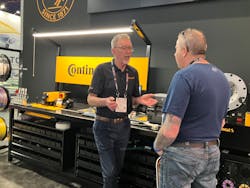Q&A: Benefits of Selecting the Right Hydraulic Hoses
Hydraulics remains an important part of Continental’s business. Recently, the company announced it will invest $40 million to create a new state-of-the-art hydraulic hose manufacturing facility in San Luis Potosi, Mexico.
The investment in the new facility will help to increase regional manufacturing capabilities and capacities as well as supply chain efficiencies. It will create multi-location capabilities across the region and is a part of Continental’s commitment to growth in North America.
In this Q&A with Alexandra Ng, Hydraulic Application Engineer at Continental, she provides her take on the hydraulics industry – why it remains a vital part of Continental’s business and how investing in high-quality hydraulic hoses can benefit customers’ own business operations.
What contributed to Continental making the decision to open a new hydraulic hose manufacturing facility? How do you see this impacting production lead times?
Alexandra Ng (AN): As a global manufacturer of hose products, further growth in hydraulics is part of our strategy. This plant is a big part of that strategy. With the additional capacity, we will be able to increase speed to market and delivery of product to our customers.
You recently attended CONEXPO-CON/AGG — North America’s largest construction show — as an exhibitor with Continental. What products were customers buzzing about at your booth?
AN: Shop in a Box was a big draw. People liked how turnkey it is. One box contains a crimper, a 96 x 36 in. work bench, fitting bins, a saw, and all the accessories you need to produce premium Continental hydraulic assemblies. We also include a tablet that connects to the CrimpCloud, which stores all the published crimp specs. Set-up is minimal. This is a great option for customers looking to get into hydraulics
We talked a lot about our new traceability feature that we offer with our crimpers. This feature allows our customers to print labels containing product information and stick to the hose. If there is a need for replacement, hose operators can then scan the QR code on the label and get all the bill of materials.
Some customers require changing out hose assemblies after being in service for a period of time for safety practice. The date of assembly is printed on the label, so this is a big help in determining when to re-order. All the information will pull from CrimpCloud where they store customer product information and history. This takes the guesswork out of identifying the parameters of the assembly (i.e. length and proper fittings).
Visit our IFPE channel for news, interviews and more from the year's largest fluid power, motion control and construction equipment events, CONEXPO & IFPEWhat do you tell hose operators who have been using the same crimper for years and are reluctant to change up their assembly operations?
AN: You can get a Shop in a Box or a stand-alone crimper from Continental. For the Shop in a Box, there is one part number for everything you need. No matter what option they choose, we make it easy for them. Our PC200i crimper model includes a CrimpIQ tablet that is connected to our CrimpCloud. All you need to do is to select the hose name, fitting and size and the crimp spec will pull up automatically. There is no need for further adjustment and customers do not need to rely on printed manuals.
Our PRO Mode feature allows you to store and save the crimp specs you use most often and skip through the steps of selecting the hose and fitting type. It goes straight to the favorited specs. Saving time = saving money!
OEMs and suppliers showcased digital and electrification solutions at the show. Do you see anything like that in the hydraulic hose business?
AN: Cloud-based data management is a hot topic. Our CrimpCloud provides a digital solution to our customers to help them manage their hose assemblies. Hose assemblies can be tracked by using our traceability labelling system that tells them when the hose was made. When there is a need for a replacement, they scan the QR code to pull up the details available on the cloud.
Our C-IQ Mobile app was launched at CONEXPO. Customers can find crimp specs so easily now. There is so much information right at your fingertips.
READ MORE: Hose Crimpers Enter the IIoT World
What are some of the latest trends you are seeing with hydraulics hose?
AN: Products that are lighter and more flexible are big right now. Companies are pushing to reduce their carbon footprint. The OEMs are designing their equipment smaller and lighter. The heavier the equipment, the more fuel it requires to do the work and move the equipment and that gets expensive. Also, the compartments of hydraulic systems are smaller for this reason. Hydraulic hoses need to be more flexible to fit in these smaller compartments.
Customers are also asking for hoses that can withstand higher temperatures. Design advancements are leading to smaller compartments of the hose make-up, leading to air circulating in a smaller space. This increases the temperature inside the hose. Outside the hose, we are all dealing with the effects of global warming and higher temperatures. Hoses need to be built to take the heat – literally.
You have been a hydraulics engineer for 22 years. How has the design of a hydraulic hose changed over the years? How is the customer voice influencing the design of hoses?
AN: I remember when 100R17 hoses used to be more rigid, now they are highly flexible with a bend radius of 3/4 of SAE. Higher tensile wire is being used now to make the product lighter and more flexible. Also, digitalization and cloud-based data management are in higher demand nowadays to improve efficiencies and the bottom line.
The voice of customer is the main driver of change at Continental. We sell through distributors and rely on them to share needs from OEM customers using the products. Shop in a Box is a great example of this. We wanted to help our customers getting into the hydraulics business and make the hose assembly process as easy as possible.
When you have the opportunity to get out in the field and see Continental hoses in action – what recommendations do you have?
AN: I often make suggestions to improve safety measures. I have seen premature failures due to poor routing or incorrect bill of material. SAE 1273 provides the recommendation for best practices for hydraulic hose assemblies. Contact the manufacturer for their recommendation on routing if needed.
Supply chain issues from the pandemic contributed to mixing and matching of hoses and fittings from different manufacturers. Each manufacturer’s designs are unique. A 1/10 in. difference on the dimensions between Manufacturer A’s fitting from Manufacturer B’s fitting could change the performance tremendously, especially for a system that experiences pressure spike.
Biggest words of advice — never mix and match manufacturers for your hoses and fittings. All hose assemblies are required to test in accordance with the specified industry specifications, such as SAE or ISO. Hose assemblies for pressure lines are required to pass the impulse test per the specified industry spec. Any mix and match components, which have not been impulse tested, could lead to premature failure at the application.
At Continental, we have 2,700 SKUs for fittings plus options for custom designs. If you have questions, contact your manufacturer.
What should customers be looking for when choosing the right hoses for their operations?
AN: The rule of thumb is to run through the S.T.A.M.P.E.D. exercise. This is the industry-wide standard that should begin every conversation when choosing a hose. It stands for Size, Temperature, Application, Material/Media, Pressure, Ends, Delivery. Once S.T.A.M.P.E.D. is completed, contact the manufacturer to have their hose expert help find the right product for you.
This article was written and contributed by ContiTech USA, part of Continental Group.
Editor’s Note: Power & Motion's WISE (Workers in Science and Engineering) hub compiles our coverage of workplace issues affecting the engineering field, in addition to contributions from equity seeking groups and subject matter experts within various subdisciplines.



